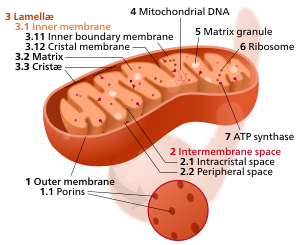Acrista(/ˈkrɪstə/;pl.:cristae) is a fold in theinner membraneof amitochondrion.The name is from the Latin forcrestorplume,and it gives the inner membrane its characteristic wrinkled shape, providing a large amount ofsurface areaforchemical reactionsto occur on. This aidsaerobic cellular respiration,because the mitochondrion requiresoxygen.Cristae are studded withproteins,includingATP synthaseand a variety ofcytochromes.
| Cell biology | |
|---|---|
| mitochondrion | |
 Components of a typical mitochondrion
4Mitochondrial DNA |
Background
editWith the discovery of the dual-membrane nature of mitochondria, the pioneers of mitochondrialultrastructuralresearch proposed different models for the organization of the mitochondrial inner membrane.[1]Three models proposed were:
- Baffle model– According toPalade(1953), the mitochondrial inner membrane is convoluted in a baffle-like manner with broad openings towards the intra-cristal space. This model entered most textbooks and was widely believed for a long time.
- Septa model–Sjöstrand(1953) suggested that sheets of inner membrane are spanned like septa (plural ofseptum) through the matrix, separating it into several distinct compartments.[2]
- Crista junction model– Daems and Wisse (1966) proposed that cristae are connected to the inner boundary membrane via tubular structures characterized by rather small diameters, termed crista junctions (CJs). In the middle of 1990s these structures were rediscovered by EM tomography, leading to the establishment of this currently widely accepted model.[3]
More recent research (2019) finds rows ofATP synthasedimers (formerly known as "elementary particles" or "oxysomes" ) forming at the cristae. These membrane-curving dimers have a bent shape, and may be the first step to cristae formation.[4]They are situated at the base of the crista. A mitochondrial contact site cristae organizing system (MICOS) protein complex occupies the crista junction. Proteins likeOPA1are involved in cristae remodeling.[5]
Crista are traditionally sorted by shapes into lamellar, tubular, and vesicular cristae.[6]They appear in different cell types. It is debated whether these shapes arise by different pathways.[7]
Electron transport chain of the cristae
editNADHis oxidized intoNAD+,H+ions,andelectronsby anenzyme.FADH2is also oxidized into H+ions, electrons, andFAD.As thoseelectronstravel farther through theelectron transport chainin the inner membrane, energy is gradually released and used to pump the hydrogen ions from the splitting of NADH and FADH2into the space between the inner membrane and the outer membrane (called theintermembrane space), creating anelectrochemical gradient.
Thiselectrochemical gradientcreates potential energy (seepotential energy § chemical potential energy) across the inner mitochondrial membrane known as theproton-motive force.As a result,chemiosmosisoccurs, and the enzymeATP synthaseproducesATPfromADPand aphosphate group.This harnesses thepotential energyfrom the concentration gradient formed by the amount of H+ions. H+ions passively pass into the mitochondrialmatrixby the ATP synthase, and later help to re-form H2O (water).
Theelectron transport chainrequires a varying supply of electrons in order to properly function and generate ATP. However, the electrons that have entered the electron transport chain would eventually pile up like cars traveling down a blocked one-way street. Those electrons are finally accepted byoxygen(O2). As a result, they form two molecules ofwater(H2O). By accepting the electrons, oxygen allows the electron transport chain to continue functioning. The chain is organized in the cristae lumen membrane, i.e. the membrane inside the junction.[5]
The electrons from each NADH molecule can form a total of 3 ATP's from ADPs and phosphate groups through the electron transport chain, while each FADH2molecule can produce a total of 2 ATPs.
As a result, 10 NADH molecules (fromglycolysisand theKrebs cycle), along with 2 FADH2molecules, can form a total of 34 ATPs duringaerobic respiration(from a single electron transport chain). This means that combined with the Krebs Cycle andglycolysis,the efficiency for the electron transport chain is about 65%, as compared to only 3.5% efficiency for glycolysis alone.
Function
editThe cristae greatly increase the surface area of theinner membraneon which the above-mentioned reactions may take place. A widely accepted hypothesis for the function of the cristae is that the high surface area allows an increased capacity for ATP generation. However, the current model is that activeATP synthasecomplexes localize preferentially in dimers to the narrow edges of the cristae. Thus, the surface area of mitochondrial membranes allocated to ATP syntheses is actually quite modest.
Mathematical modelling suggested that the optical properties of the cristae in filamentous mitochondria may affect the generation and propagation of light within the tissue.[8]
References
edit- ^Griparic, L; van der Bliek, AM (August 2003)."The many shapes of mitochondrial membranes".Traffic.2(4): 235–44.doi:10.1034/j.1600-0854.2001.1r008.x.PMID11285133.S2CID9500863.
- ^Sjostrand, F (Jan 3, 1953). "Systems of double membranes in the cytoplasm of certain tissue cells".Nature.171(4340): 31–32.doi:10.1038/171031a0.S2CID6765607.
- ^Zick, M; Rabl, R; Reichert, AS (January 2009)."Cristae formation-linking ultrastructure and function of mitochondria".Biochimica et Biophysica Acta (BBA) - Molecular Cell Research.1793(1): 5–19.doi:10.1016/j.bbamcr.2008.06.013.PMID18620004.
- ^Blum TB, Hahn A, Meier T, Davies KM, Kühlbrandt W (March 2019)."Dimers of mitochondrial ATP synthase induce membrane curvature and self-assemble into rows".Proceedings of the National Academy of Sciences of the United States of America.116(10): 4250–4255.Bibcode:2019PNAS..116.4250B.doi:10.1073/pnas.1816556116.PMC6410833.PMID30760595.
- ^abBaker, Nicole; Patel, Jeel; Khacho, Mireille (November 2019)."Linking mitochondrial dynamics, cristae remodeling and supercomplex formation: How mitochondrial structure can regulate bioenergetics".Mitochondrion.49:259–268.doi:10.1016/j.mito.2019.06.003.PMID31207408.
- ^Hanaki M, Tanaka K, Kashima Y (1985). "Scanning electron icroscopic study on mitochondrial cristae in the rat adrenal cortex".Journal of Electron Microscopy.34(4): 373–380.PMID3837809.
- ^Stephan, Till; Roesch, Axel; Riedel, Dietmar; Jakobs, Stefan (27 August 2019)."Live-cell STED nanoscopy of mitochondrial cristae".Scientific Reports.9(1): 12419.Bibcode:2019NatSR...912419S.doi:10.1038/s41598-019-48838-2.PMC6712041.PMID31455826.
- ^Thar, R.and M. Kühl (2004). "Propagation of electromagnetic radiation in mitochondria?".J.Theoretical Biology,230(2), 261-270.[1]Archived2013-07-18 at theWayback Machine